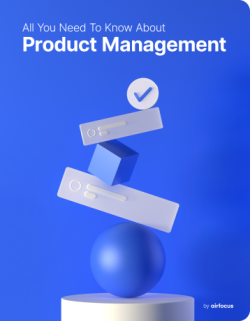
Dealing with stress can be a difficult task for anyone — but for product managers, it can be that little bit more intense. Not only are you trying to deal with your own stress, but it can also fall to you to help manage your teammates’ stress levels too.
Then there’s the job itself.
Becoming a product manager is an extremely exciting prospect, but some of the cool parts of the job are also the parts that can stress you out the most. It’s your responsibility to make decisions that will directly impact commercial performance, and you need to stay at the forefront of innovation and tech developments.
There’s so much you need to do (often at once), so it’s no surprise that PMs can feel burned out.
Product management can be a hard job with multiple stressors — and research backs this up. A 2021 study found that:
17% of product managers found product management emotionally taxing
21% were unhappy with the lack of resources available
22% disliked dealing with reactive versus proactive tasks
27% disliked the internal politics that came with the role
Fortunately, the study suggests that stress management had gotten better since the previous year, when 28% of product managers disliked internal politics, and 25% were unhappy with the lack of resources.
So the question is: what can product people do to keep the work fun and reduce anxiety levels?
We’re about to draw upon a product management favorite: SMART goals and how we can use SMART goals for stress management and minimization.
Benefits of SMART goals for stress management
Why should you start working with SMART goals as part of your stress management plan?
Here are the main benefits:
Improved teamwork and morale
Increased productivity
Better focus
Improved time organization
Increased chances of success
Easier performance monitoring
Understand resources availability and limitations (e.g. realizing you need extra staff or new roles)
4 examples of SMART goals for stress management in busy product teams
The SMART goal-setting tool is a simple framework. It can be performed by anyone and applied to any aspect of business — or even life outside of work.
As the acronym suggests, the SMART framework helps shape goals that are:
Specific
Measurable
Attainable
Relevant
Time-Bound
Combining these elements together brings clarity, drives motivation, and increases success. When we use the SMART framework for business-related tasks, we're more likely to hit our goals. So, why don’t we apply that framework to our ways of managing stress?
Let’s see how that can be done.

Stress factor: We're running out of time before launch
We’ve all been there. Deadline day is looming large and there’s still so much left to do. It’s enough to stress anyone out.
SMART goal: Establish a clear timeline between now and the go-live
Sometimes the amount of work you need to do looks far more intensive than it actually is. By setting a SMART goal, you can get a clear picture of what you need to do within the timeframe you have left.
The deadline fits the time-bound criteria already, and your measurable criteria is simply whether the work is finished within that time or not. To create a SMART goal you just need to fill the other three.
You can discover the specific details of your SMART goal by looking at the work you have remaining. This is also the stage where you can figure out if the amount of work is attainable within the timeframe.
You can use a prioritization framework to judge how long the remaining tasks will take and how relevant they are to the process.
Using what you have learned by gathering information to fit your SMART goal, you can create a schedule that helps to break down tasks into smaller, manageable pieces.
This is a simple but highly effective example of how SMART goals for stress management can re-align a panicked product team and help you achieve your targets.
Stress factor: Conflict within the team
There’s bound to be conflict with any group of people who spend the majority of their time with one another.
Throw in an ambitious deadline or the challenges of remote decision-making and — as much as we try to prevent it — conflict within your team is inevitable and can be a major cause of stress.
Setting a SMART goal to deal with conflict within the team can help resolve conflict with minimal disruption to productivity levels.
SMART goal for stress management: Take action before the problem gets worse
One of the main causes of escalating conflict is poor communication between teammates, especially if there’s tension. Many co-workers would prefer to just wait for the tension to ease and avoid the other person until then. Of course, this is a terrible idea for a team that needs to work as one to produce high-quality products.
In this scenario:
Your specific details are the conflict, the people involved, and the subject that caused it.
Your measurables are increased collaboration and a reduction in time wastage.
The attainable goal is to resolve the conflict as soon as possible, as its relevance is due to the impact on productivity.
Resolving conflict is also an urgent task, making it a time-bound activity that needs to be completed ASAP.
Stress factor: Screen-time burnout
The amount of screen time we have has grown massively, especially over the past two years.
It will come as no surprise that many of us are feeling burned out from staring at our screens for days on end. But it’s tough to find work that doesn’t involve being in front of the screen — especially within product management!
Studies also show that sitting at your desk for too long has a whole range of worrying health implications. So let’s get a SMART goal together to help reduce screen-time burnout and give your health a little boost.

SMART goal for stress management: Be more active in the office or while working from home
This one’s straightforward. Your specific details are the amount of time you spend sitting at your desk and how it impacts your health.
You can measure your progress by logging how often you get up and move around.
It’s an attainable goal, as you don’t need to do all that much and can set an alarm to remind you to be more active.
It’s relevant because you should be doing all you can to support your mental and physical help.
Finally, your time-bound criteria comes from how often you get up and go, ideally once every 20 minutes.
Stress factor: Dealing with difficult stakeholders
Keeping stakeholders satisfied isn’t always easy. PMs often have their work cut out when handling tough questions and managing expectations.
SMART goal: Prioritize your stakeholders and their requests
When you prioritize stakeholders and their requests, you know what to deal with first and what can wait. Only some stakeholders are going to be (or can be) your top priority, so sorting them and their requests carefully can help you take positive action.
In this scenario:
Write a complete list of the specific things each stakeholder requests.
Prioritize those requests with a measurable ranking system, so you’ll know which are most important.
You’re not trying to handle all the requests simultaneously, and you’re not overwhelmed by them. You’re just organizing them to help you manage them in a better, more attainable way.
Decide which requests are relevant to product success and put the rest on the back burner for now.
Prioritize stakeholder requests and set up a timeline to deal with them — a simple approach to achieving time-bound goals.
Stress factor: Managing multiple products at the same time
You have a bunch of products to juggle, things are getting a little crazy, and you don’t know what to do. That’s why you feel like nothing is getting done.
SMART goal: Allocate specific time slots in your weekly calendar to work on each product
This stress management approach helps you know when to work on what and can help take some of the chaos out of managing multiple products at once. You need to allocate time based on each product’s priorities.
Set aside specific time to work on each product.
Devote a set amount of time to each product so your schedule doesn’t get out of hand — it’s measurable, attainable, and time-bound.
Prioritize each product’s tasks so you only spend time working on what matters most and don’t get sidetracked. You’re focusing on what’s most relevant first.
This SMART goal helps you work on multiple products at the same time in a more straightforward way.
Stress factor: Teams are unmotivated
It’s getting to the end of a sprint, your team is tired, uninspired, and unmotivated. It’s your job to try and inject some life back into them, even when you’re swamped with a million other tasks.
SMART goal for stress management: Introduce an employee recognition scheme to boost morale in the next 6 months
Introducing an employee recognition scheme is a great way to make employees feel happier at work.
The specific details here are introducing the new scheme to attain an improved level of employee satisfaction.
This will be measured through regular employee satisfaction surveys between now and the goal will be time-bound over the 6 months.
This is relevant to the entire team and business going forward, as unhappy team members will start feeling more comfortable voicing their concerns and will feel more appreciated, and therefore more motivated.
For more helpful resources and support for product managers, make sure to keep subscribed to the airfocus blog!

Tomas Prochazka

Read also





Experience the new way of doing product management

Experience the new way of doing product management



